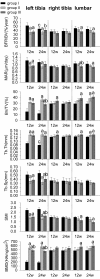Peri-implant and systemic effects of high-/low-affinity bisphosphonate-hydroxyapatite composite coatings in a rabbit model with peri-implant high bone turnover
- PMID: 22686414
- PMCID: PMC3414815
- DOI: 10.1186/1471-2474-13-97
Peri-implant and systemic effects of high-/low-affinity bisphosphonate-hydroxyapatite composite coatings in a rabbit model with peri-implant high bone turnover
Abstract
Background: Hydroxyapatite (HA) coatings composed with bisphosphonates (BPs) which have high mineral-binding affinities have been confirmed to successfully enhance implant stability. However, few previous studies focused on HA coatings composed with low-affinity BPs or on systemic effects of locally released BPs.
Methods: In this long-term study, we developed two kinds of BP-HA composite coatings using either high-affinity BP (alendronate, ALN) or low-affinity BP (risedronate, RIS). Thirty-six rabbits were divided into three groups according to different coating applications (group I: HA, group II: ALN-HA, and group III: RIS-HA). Implants were inserted into the proximal region of the medullary cavity of the left tibiay. At insertion, 2 × 10(8) wear particles were injected around implants to induce a peri-implant high bone turnover environment. Both local (left tibias) and systemic (right tibias and lumbar vertebrae) inhibitory effect on bone resorption were compared, including bone-implant integration, bone architecture, bone mineral density (BMD), implant stability, and serum levels of bone turnover markers.
Results: The results indicated that ALN-HA composite coating, which could induce higher bone-implant contact (BIC) ratio, bone mass augmentation, BMD, and implant stability in the peri-implant region, was more potent on peri-implant bone, while RIS-HA composite coating, which had significant systemic effect, was more potent on non-peri-implant bone, especially lumbar vertebrae.
Conclusions: It is instructive and meaningful to further clinical studies that we could choose different BP-HA composite coatings according to the patient's condition.
Figures






References
-
- Peter B, Gauthier O, Laïb S, Bujoli B, Guicheux J, Janvier P, van Lenthe GH, Müller R, Zambelli PY, Bouler JM, Pioletti DP. Local delivery of bisphosphonate from coated orthopedic implants increases implants mechanical stability in osteoporotic rats. J Biomed Mater Res A. 2006;76:133–143. - PubMed
-
- Faucheux C, Verron E, Soueidan A, Josse S, Arshad MD, Janvier P, Pilet P, Bouler JM, Bujoli B, Guicheux J. Controlled release of bisphosphonate from a calcium phosphate biomaterial inhibits osteoclastic resorption in vitro. J Biomed Mater Res A. 2009;89:46–56. - PubMed
MeSH terms
Substances
LinkOut - more resources
Full Text Sources

